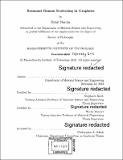Resonant Raman scattering in graphene
Author(s)
Narula, Rohit
DownloadFull printable version (30.40Mb)
Other Contributors
Massachusetts Institute of Technology. Department of Materials Science and Engineering.
Advisor
Stephanie Reich and Nicola Marzari.
Terms of use
Metadata
Show full item recordAbstract
In this thesis we encounter the formulation of a rigorous theory of resonant Raman scattering in graphene, the calculation of the so-obtained Raman matrix element K2f,1o for the 2D Raman mode with the full inclusion of the matrix elements and a physically appealing bridge between theory and experiment by eschewing the problematic ascription of graphene with a finite thickness. Finally, we elucidate an experimental study of the Raman D and G modes of graphene and highly-defected pencil graphite over the visible range of laser radiation. Marking a departure from the usual practice for light scattering in semiconductors of including only the dynamics of the electrons and holes separately, we show via fourth-order quantum mechanical perturbation theory using a Fock state basis that for resonant Raman scattering in graphene the processes to leading order are those that involve the simultaneous action of the electrons and holes. Such processes are indeed an order of magnitude stronger than those prevalent in the literature under the double resonance [1, 2, 3] moniker. We translate our perturbation theoretic analysis into simple rules for constructing Feynman diagrams for processes to leading order and we thereby enumerate the 2D and D modes. Using expressions for the terms to leading order obtained from our theoretical treatment we proceed to evaluate the Raman matrix element [4] for the Raman 2D mode by using state-of-the-art electronic [5] and iTO phonon dispersions [6] fit to ab initio GW calculations. For the first time in the literature we include the variation of the light-matter and electron-phonon interaction matrix elements calculated via an ab initio density functional theory (DFT) calculation under the local density approximation (LDA) for the electronic wavefunctions. Our results for the peak structure, position and intensity dependence are in excellent agreement with experiments [7, 8, 9, 10]. Strikingly, our results show that depending on the combination of the input (polarizer) and output (analyzer) polarization of the laser radiation, very different regions of the phonon dispersion are accessed. This has a direct impact on the dominant electronic transitions according to the pseudo-momentum conservation condition satisfied by the scattering of an electron by a phonon ki = kf + q. Using sample substitution [11] we deconvolve the highly wavelength dependent response of the spectrometer from the Raman spectra of graphene suspended on an SiO2 - Si substrate and graphite for the D and G modes in the visible range. We derive a model that considers graphene suspended on an arbitrary stratified medium while sidestepping its problematic ascription as an object of finite thickness and calculate the absolute Raman response of graphene (and graphite) via its explicitly frequency independent Raman matrix element [K'2f10]2 vs. laser frequency. For both graphene and graphite the [K'2f10]2 per graphene layer vs. laser frequency rises rapidly for the G mode and less so for the D mode over the visible range. We find a dispersion of the D mode position with laser frequency for both graphene and graphite of 41 cm-YeV and 35 cm-YeV respectively, in good agreement with Narula and Reich 131 assuming constant matrix elements, the observed intensity follows the joint density states of the electronic bands of graphene. Finally, we show the sensitivity of our calculation to the variation in thickness of the underlying SiO2 layer for graphene.
Description
Thesis: Ph. D., Massachusetts Institute of Technology, Department of Materials Science and Engineering, February 2011. Cataloged from PDF version of thesis. Includes bibliographical references (pages 131-144).
Date issued
2011Department
Massachusetts Institute of Technology. Department of Materials Science and EngineeringPublisher
Massachusetts Institute of Technology
Keywords
Materials Science and Engineering.